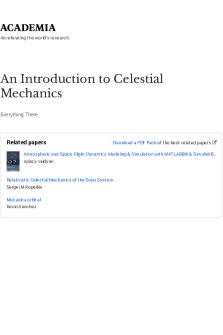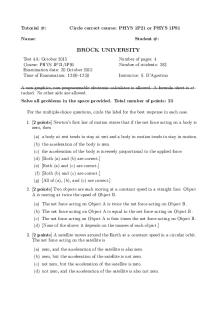Mechanics and Introduction to Relativity Test 4a PDF

| Title | Mechanics and Introduction to Relativity Test 4a |
|---|---|
| Course | Mechanics and Introduction to Relativity |
| Institution | Brock University |
| Pages | 4 |
| File Size | 60.1 KB |
| File Type | |
| Total Downloads | 59 |
| Total Views | 142 |
Summary
Test 4a...
Description
Tutorial #:
Circle correct course: PHYS 1P21 or PHYS 1P91
Name:
Student #:
BROCK UNIVERSITY Test 4A: October 2015 Course: PHYS 1P21/1P91 Examination date: 20 October 2015 Time of Examination: 12:00–12:50
Number of pages: 4 Number of students: 283 Instructor: S. D’Agostino
A non-graphics, non-programmable electronic calculator is allowed. A formula sheet is attached. No other aids are allowed. Solve all problems in the space provided. Total number of points: 25 For the multiple-choice questions, circle the label for the best response in each case. 1. [2 points] Newton’s first law of motion states that if the net force acting on a body is zero, then (a) a body at rest tends to stay at rest and a body in motion tends to stay in motion. (b) the acceleration of the body is zero. (c) the acceleration of the body is inversely proportional to the applied force. (d) [Both (a) and (b) are correct.] (e) [Both (a) and (c) are correct.] (f) [Both (b) and (c) are correct.] (g) [All of (a), (b), and (c) are correct.] 2. [2 points] Two objects are each moving at a constant speed in a straight line. Object A is moving at twice the speed of Object B. (a) The net force acting on Object A is twice the net force acting on Object B. (b) The net force acting on Object A is equal to the net force acting on Object B. (c) The net force acting on Object A is four times the net force acting on Object B. (d) [None of the above; it depends on the masses of each object.] 3. [2 points] A satellite moves around the Earth at a constant speed in a circular orbit. The net force acting on the satellite is (a) zero, and the acceleration of the satellite is also zero. (b) zero, but the acceleration of the satellite is not zero. (c) not zero, but the acceleration of the satellite is zero. (d) not zero, and the acceleration of the satellite is also not zero.
4. [2 points] An object is thrown upwards. As the object moves upwards, the object slows down gradually because (a) the force of the throw gradually dissipates. (b) the force of the throw is gradually overcome by gravity. (c) the gravitational force gradually increases, as it has more time to act. (d) [None of the other alternatives is correct.] 5. [2 points] A large, massive truck crashes into a building, causing a lot of damage to the building. The force exerted by the truck on the building (a) is greater than the force exerted by the building on the truck. (b) can’t be compared to the force exerted by the building on the truck; the building doesn’t exert a force on the truck, it just gets in the way of the truck’s motion. (c) is inversely proportional to the acceleration of the truck. (d) [None of the other alternatives is correct.] 6. [2 points] You are in the passenger seat of a car that drives to the left around a sharp curve at high speed. You feel that you are thrown towards the right passenger door. (a) The force of the car’s motion is pushing you towards the door. (b) A centrifugal force is pushing you towards the door. (c) No force is pushing you towards the door; it just feels that way because of your inertia. (d) A centripetal force is pushing you towards the door. 7. [2 points] Two objects fall from rest in a vacuum chamber on Earth. The mass of Object A is twice as large as the mass of Object B. (a) The speed of Object A is twice the speed of Object B, because the gravitational force on A is twice the gravitational force on B. (b) The acceleration of Object A is twice the acceleration of Object B, because the gravitational force on A is twice the gravitational force on B. (c) Objects A and B fall with the same speed. (d) [Both (a) and (b) are correct.] (e) [None of the other alternatives is correct.] 8. [2 points] A helicopter flies directly west at a constant speed. When the helicopter is directly over the Brock tower, a passenger releases a bundle of physics textbooks that is hanging from the helicopter. If we can neglect air resistance, the books land (a) to the west of the tower. (b) directly on the roof of the tower. (c) to the east of the tower. (d) [None of the other alternatives is correct.]
9. [2 points] An elevator is being lifted upwards at a constant speed by a cable. Compare the force F1 exerted by the cable on the elevator to the gravitational force F2 exerted by the Earth on the elevator. (All other forces are negligible.) (a) F1 > F2 (b) F1 = F2 (c) F1 < F2 (d) [Not enough information is included to determine which alternative is correct.] 10. [2 points] When a truck pulls a trailer, the force exerted by the truck on the trailer is equal and opposite to the force exerted by the trailer on the truck. Therefore the net force is zero, because the sum of the two forces in the previous sentence is zero. (a) The first sentence is true, by Newton’s third law. The second sentence is false, because the forces act on different objects, so adding them makes no sense. (b) The first sentence is false, because if the forces were equal how would they be able to move? The second sentence is also false, because if the net force were zero, how would they be able to move? (c) The first sentence is false, but the second sentence is true. (d) The first sentence is true, and the second sentence is also true. 11. [2 points] A hot-air balloon is rising upward with a constant speed of 2.5 m/s. When the balloon is 3.0 m above the ground, the balloonist accidentally drops a compass over the side of the balloon. Determine how much time passes until the compass hits the ground.
12. [3 points] A cannonball is fired at a speed of 75.0 m/s from ground level, at an angle of 60◦ above the horizontal. The cannonball is fired toward an 11.0-m-high wall, which is located 27.0 m away. By how much does the cannonball clear the top of the wall?...
Similar Free PDFs

Introduction to Fluid Mechanics
- 321 Pages

Module 1 Introduction To Mechanics
- 11 Pages

An Introduction to Celestial Mechanics
- 217 Pages

Fay - Introduction to Fluid Mechanics-1
- 232 Pages
Popular Institutions
- Tinajero National High School - Annex
- Politeknik Caltex Riau
- Yokohama City University
- SGT University
- University of Al-Qadisiyah
- Divine Word College of Vigan
- Techniek College Rotterdam
- Universidade de Santiago
- Universiti Teknologi MARA Cawangan Johor Kampus Pasir Gudang
- Poltekkes Kemenkes Yogyakarta
- Baguio City National High School
- Colegio san marcos
- preparatoria uno
- Centro de Bachillerato Tecnológico Industrial y de Servicios No. 107
- Dalian Maritime University
- Quang Trung Secondary School
- Colegio Tecnológico en Informática
- Corporación Regional de Educación Superior
- Grupo CEDVA
- Dar Al Uloom University
- Centro de Estudios Preuniversitarios de la Universidad Nacional de Ingeniería
- 上智大学
- Aakash International School, Nuna Majara
- San Felipe Neri Catholic School
- Kang Chiao International School - New Taipei City
- Misamis Occidental National High School
- Institución Educativa Escuela Normal Juan Ladrilleros
- Kolehiyo ng Pantukan
- Batanes State College
- Instituto Continental
- Sekolah Menengah Kejuruan Kesehatan Kaltara (Tarakan)
- Colegio de La Inmaculada Concepcion - Cebu











